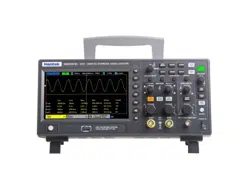Loading ...
Loading ...
Loading ...

User Manual
13 / 68
the input channel. Uncompensated or miscompensated probes may lead to errors or faults in measurement. To adjust the probe
compensation, follow the steps below.
1. Set the Probe option attenuation in the channel menu to 10X. Set the switch on the probe to 10X and connect the probe to
Channel 1 on the oscilloscope. If you use the probe hook-tip, ensure it is firmly inserted onto the probe. Attach the probe tip to
the PROBE COMP ~2V@1KHz connector and the reference lead to the PROBE COMP Ground connector. Display the channel
and then press the Auto Scale button.
2. Check the shape of the displayed waveform.
3. If necessary, use a nonmetallic screwdriver to adjust the variable capacity of your probe until the shape of the waveform
turns to be the same as the above figure. Repeat this step as necessary. See the figure below for the way of adjustment.
1.6.3. Probe Attenuation Setting
Probes are of various attenuation factors which affect the vertical scale of the signal. The Probe Check function is used to verify
if the Probe attenuation option matches the attenuation of the probe.
You can push a vertical menu button (such as the CH1 MENU button) and select the Probe option that matches the attenuation
factor of your probe.
Make sure that the Attenuation switch on the probe matches the Probe option in the oscilloscope. Switch settings are 1X and
10X.
When the Attenuation switch is set to 1X, the probe limits the bandwidth of the oscilloscope to 6MHz. To use the full bandwidth
of the oscilloscope, be sure to set the switch to 10X.
Compensated correctly
Overcompensated
Undercompensated
Loading ...
Loading ...
Loading ...
